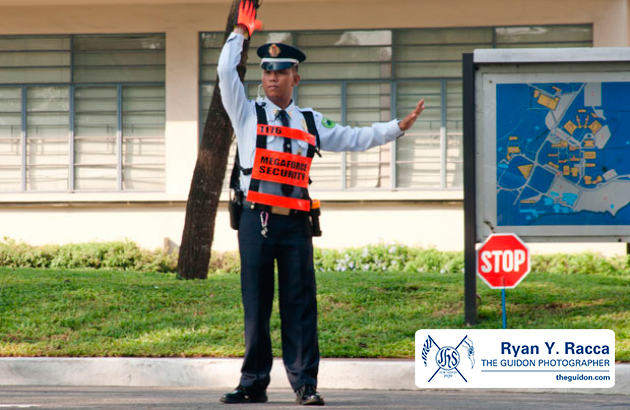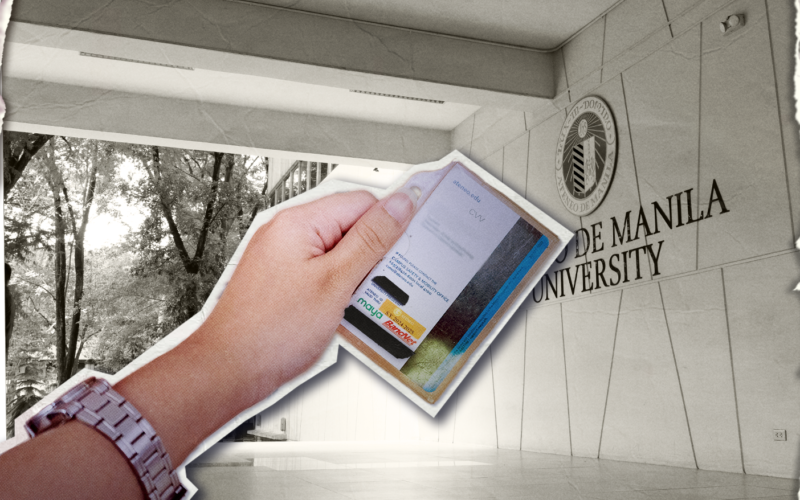Campus security is fundamental to the functionality of every school. Although the Ateneo university administration has taken great care to maintain the security on campus, it does not insure against risk.
The school has experienced plenty of on-campus crimes and emergencies in recent years, under both Leopard Security and Investigation Agency’s (LSIA) and Megaforce Integrated Security Agency’s (MISA) watch.
In August of 2011, a thief took two laptops from a student’s car while it was parked near the covered courts. The car’s windows had been smashed and the doors unlocked, yet there were no guards in the area to apprehend the thief.
According to the students, the LSIA guards were reluctant to help them report the theft to the Quezon City police precinct. The school administration then conducted an internal investigation on the matter, in case it was an inside job. A month after this incident, the Ateneo community was shocked by the announcement that MISA would officially replace LSIA.
Two years have passed since the transition from LSIA to MISA as the Ateneo’s campus security agency. Given the recent thefts on campus, it is time to scrutinize MISA’s work thus far.
Changing agencies
On July 19, 2011, Loyola Schools President Fr. Jose Ramon Villarin, SJ announced the replacement of the school’s security force. The Ateneo community was understandably surprised, as LSIA had been serving the campus for nine years.
“The Ateneo admin must have had a compelling reason for it to decide the change of security agencies,” says Leo Camacho, a member of the Ateneo Management Association, in a 2011 segment of The GUIDON’s Atenean Voice.
LSIA filed an appeal after the formal announcement of the change. Villarin turned the request down, clarifying that “the decision does not in any way suggest that Leopard’s service was unsatisfactory these last nine years nor does it question its track record within and outside the Loyola campus.” Villarin said this in The GUIDON News article entitled “New security agency takes over Loyola Schools,” published in 2011.
In a 2011 article from The GUIDON entitled “Security Check,” the Facilities Management Office (FMO) Director Jose Arnulfo Batac explained that the bidding process that preceded the security change was standard operating procedure. Ideally, it should be held every three years.
Imelda Nibungco, the Director of the Human Resources Management Office, explained that no bidding processes were conducted in the past because the former Physical Plant Administrator Leoncio Miralao, Jr., did not think it was needed. The Ateneo Physical Plant supervises the maintenance and security personnel of the Ateneo Grade School.
Megaforce
The bidding committee that was formed in April 2011 was tasked with reviewing proposals from applying security agencies. MISA scored highest in both the technical aspect (constituting 75% of the total score) and the financial aspect.
Established in 1992, MISA was recognized as the Most Outstanding Private Security Agency by the Civil Security Group in 2002. However, it has since been associated with several controversies.
In a previous interview with The GUIDON, MISA Commander and Area Supervisor Jun Deiparine said that MISA’s primary goal is to watch over the welfare of the Ateneo community. According to Deiparine, it is the duty of MISA to protect people and property while establishing a “harmonious relationship” with members of the community.
MISA formally took over security duties in September 2011. This was done after double-posting, wherein LSIA guards accompanied their MISA counterparts during their shifts.
However, multiple thefts soon after caused the Ateneo community to doubt MISA’s competence. These robberies involved the loss of six LCD monitors, one Wi-Fi router and one of the Mathematics Department’s central processing units, as well as two student-owned cars being broken into. FMO decided to charge all costs to MISA.
In another 2011 segment of Atenean Voice, Levi Vitug (BS Mgt ’12) commented that MISA security guards were not as strict as those of the previous agency. True enough, Associate Dean of Student Affairs Rene San Andres said that most of the recent thefts started with thieves entering the campus by taxi or tricycle and with stolen or fake IDs.
When asked if the current security system has emergency drills other than those for fires and earthquakes, San Andres said that the university has no emergency drills for hostage crises.
Students continue to question MISA’s leniency and whether it is truly able to protect the Ateneo community.
Level of security
The Ateneo campus—including the Ateneo Grade School and the Ateneo High School—occupies an area of around 83 hectares. While the campus is gated along Katipunan Avenue, it is not possible to lock down the entire campus, owing to its land area. Its perimeter has two points of pedestrian ingress and egress that do not have gates: The concrete steps which descend to Barangay Barangka Marikina and the narrow pathway connecting the Ateneo high school parking area and the southwestern portion of the Miriam College property.
The Ateneo has security guards visually check student IDs, while entry to the New Rizal Library is monitored through automated ID scanners. Students from both the University of Santo Tomas and the University of the Philippines Diliman (UPD) also present their IDs manually. The students of the De La Salle University (DLSU), on the other hand, must present their ID for automated scanning before being allowed entry into the 5.04-hectare campus.
San Andres says that automated scanning may not be possible for all parts of the Ateneo. This is because entrances to the campus are open-air, unlike the enclosed entrances of schools like DLSU.
UPD, a 493-hectare campus, employed a car sticker system to regulate the entry and exit of vehicles. In May 2013, UPD began testing a new automated barrier gate system. San Andres says that the administration has started to talk about installing a similar barrier system in the Ateneo.
He also comments that with “all the guards around, including the undercover ones,” the Ateneo merits a seven out of ten on his security scale.
The security system of the Ateneo is functional, unobtrusive and non-constricting. It allows members of the Ateneo community the freedom to go about their daily tasks with the assurance that they are safe on campus.
Constant vigilance
According to San Andres, the current security system of the Ateneo is fair because “our system anchors on the vigilance of every student.” He says that the reason the ID wearing policy is part of the Code of Discipline is that every one in the Ateneo community is “a part of the whole system.” For San Andres, students are the “primary defense of the campus.” Strict ID implementation allows security guards to distinguish between bona fide students of the Ateneo and possible thieves.
The main threat to the safety of members of the Ateneo community lies directly outside the campus: Places like Katipunan Avenue, the pedestrian walkways, the Light Rail Transit 2 station and beyond, where the Quezon City local government and police have jurisdiction. Quezon City is no different from other cities in Metro Manila—it has a high crime rate and has many threats to the security of persons and property. Once outside the safe confines of the Ateneo, students are on their own.
San Andres reminds Ateneans to be simple in their lifestyle so as not to attract undue attention to themselves or their possessions. He recalls instances when industrious thieves victimized negligent students. He cautions students against a “culture of entitlement,” where everything that happens to them is “someone else’s responsibility and other people’s fault.”
“Everyone must remain vigilant,” says San Andres. “Students must do their part to assure the safety and security of the whole community.”
Incidents of theft in the Ateneo
June 17, 2008, Cervini Hall Waiting Shed
At around 8:40 PM, a robber took three dormers’ cellphones and laptops while they were sitting in the Cervini Hall waiting shed. The dormers immediately alerted the guard in Cervini. Though the security officers blocked all exit points, the robber was not caught. A security office report described the man as “fair-skinned and muscular.” Because of limited information on the incident, administrators said they were not optimistic that the robber would ever be caught.
June 17, 2009, Gonzaga Cafeteria
A thief and his three cohorts entered the Ateneo campus in a taxi and attempted to steal a student’s backpack in the Gonzaga Cafeteria. An undercover guard spotted them surrounding a table, grabbing a bag left by a student. The group split up and left the cafeteria in different directions. The guard followed the thief carrying the student’s bag, then asked another guard to apprehend him near the tricycle terminal. The student initially wanted to file charges but changed her mind at the police station.
March 12, 2012, Schmitt Hall
A thief attempted to take a student’s laptop at Schmitt Hall at around 3:00 PM. A security guard stationed in the building saw the suspect enter and take the laptop on the second floor. The officer radioed for backup and tailed the suspect to the tricycle station near the Gonzaga Hall drop-off. Several security officers apprehended the suspect while he was in a moving tricycle. The suspect claimed that it was his first theft attempt in the Ateneo but his thorough knowledge of security routines suggested otherwise.
January 7, 2013, Gonzaga Cafeteria
A construction worker posing as a student attempted to steal three backpacks in the Gonzaga Cafeteria. An undercover guard noticed him picking up the bags. The security guard ran after the thief and cornered him before he reached the tricycle terminal outside the building. With an Apple iPod, a Samsung cellphone and cash, the contents of the bags reportedly amounted to a total of P31,700. The suspect was detained in a police station.
April 23, 2013, Blue Eagle Gym
Thieves ransacked the Blackwater Sports locker during their Philippine Basketball Association D-League match with EA Regens at the Blue Eagle Gym. “Money, cellphones, gadgets, as well as ATM and credit cards” were stolen, according to Blackwater coach Leo Isaac. The players filed their testimonies to investigators on the scene immediately after the game. University Athletics Office Director Ricky Palou commented that he was puzzled as to how thieves were able to break into the Blackwater dugout, given there was a guard stationed at its only doorway throughout the game.







